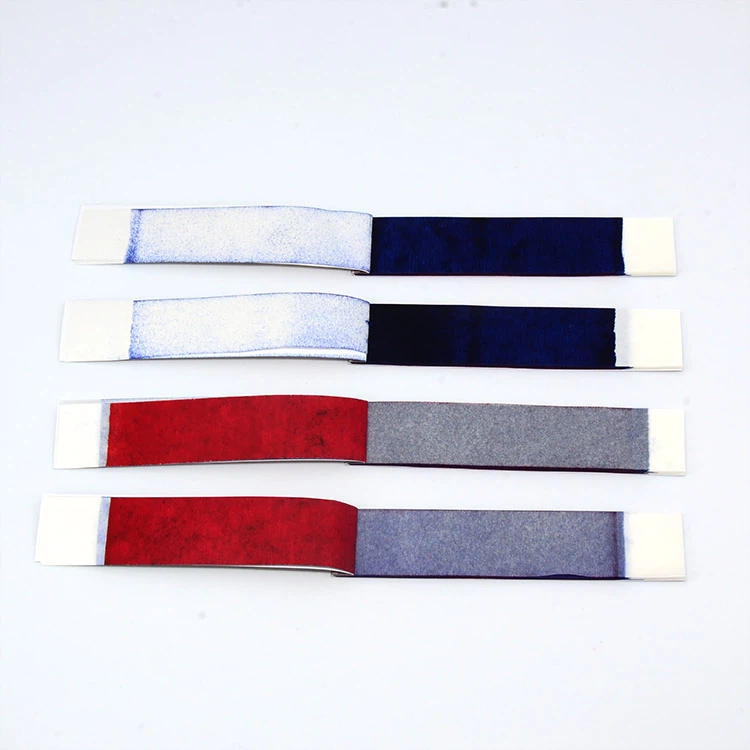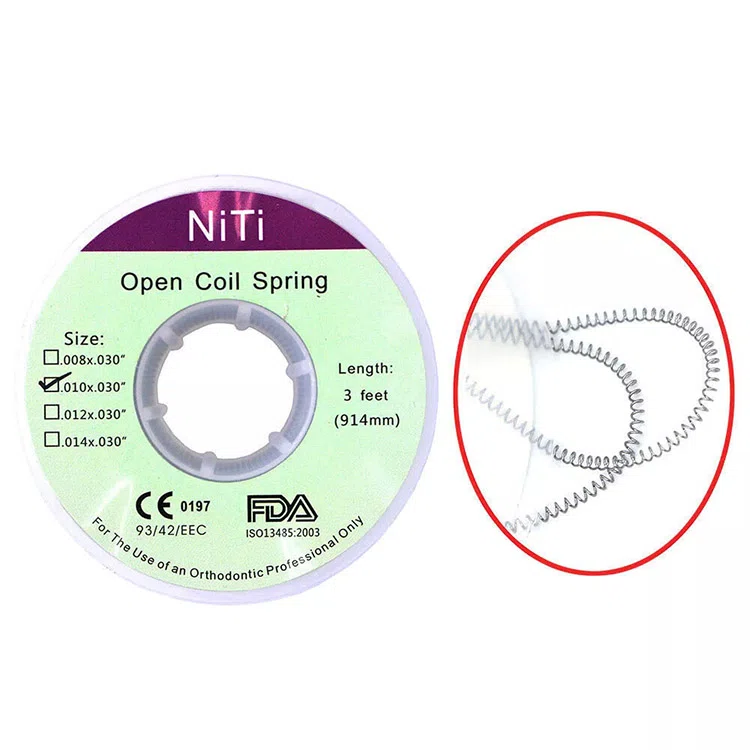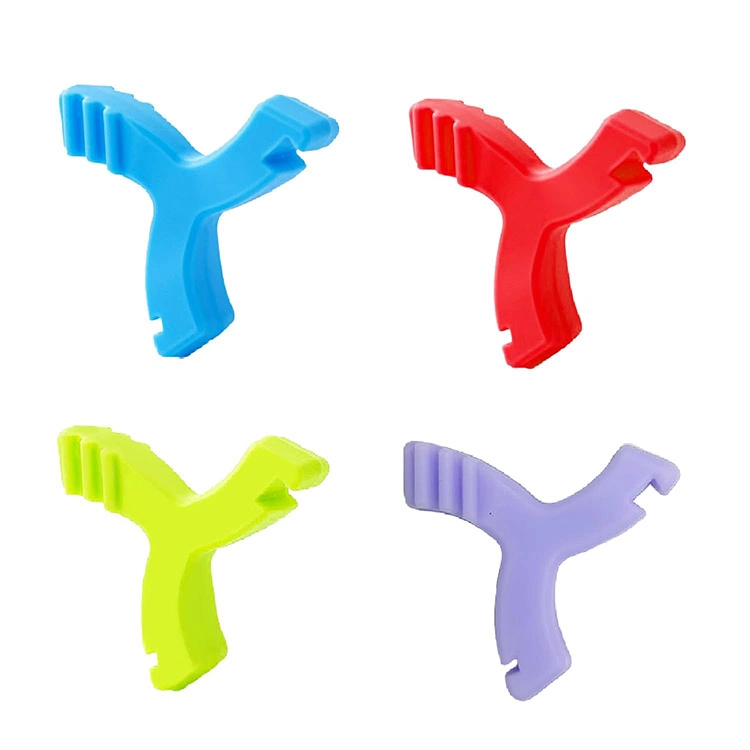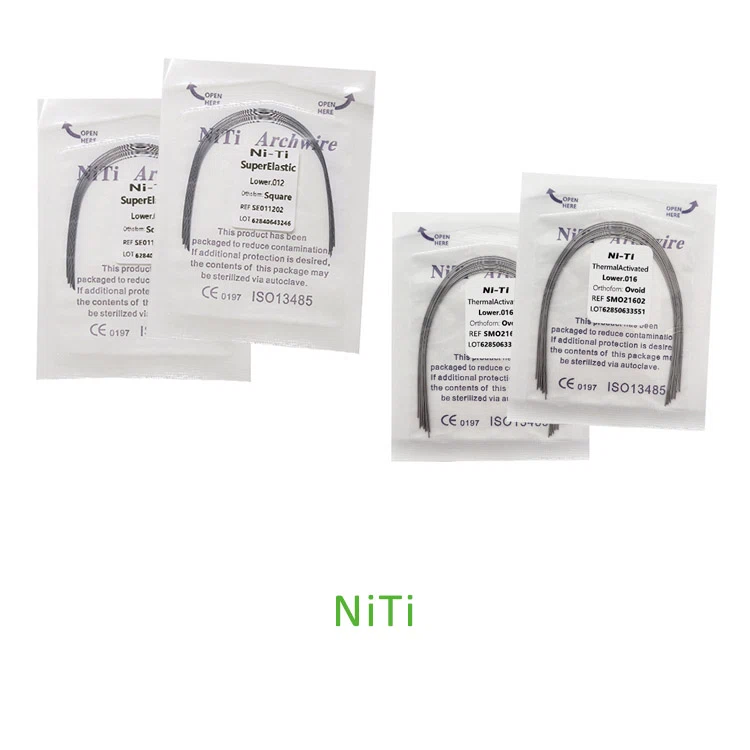
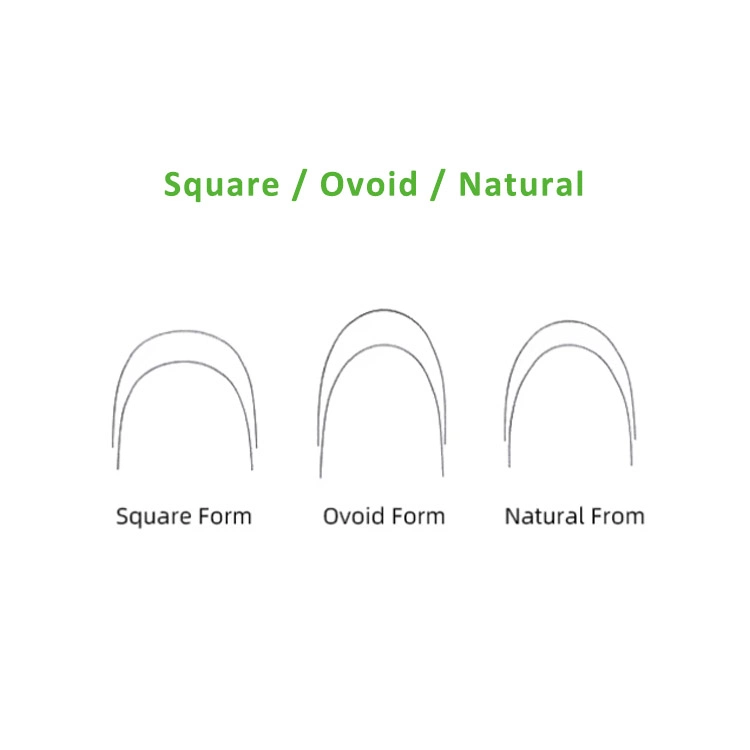
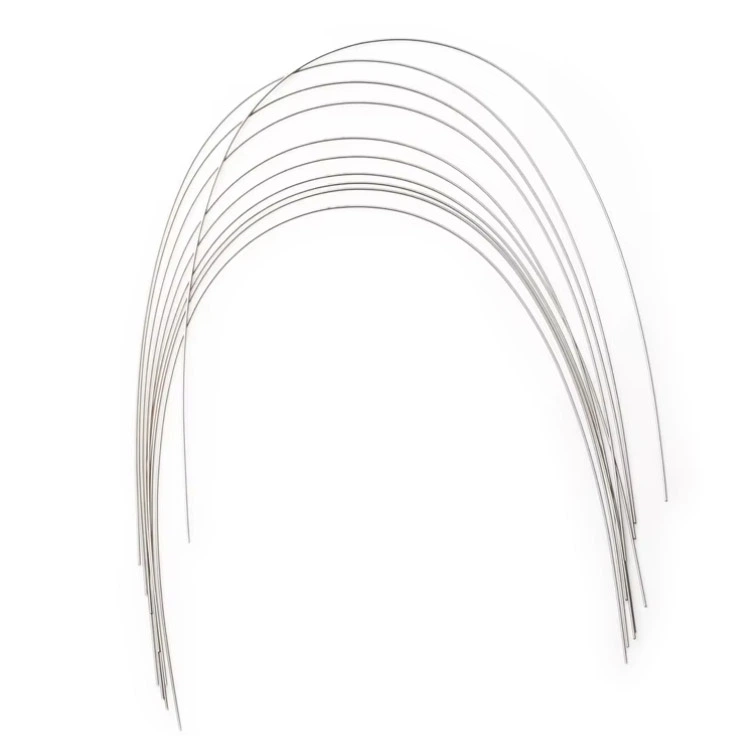
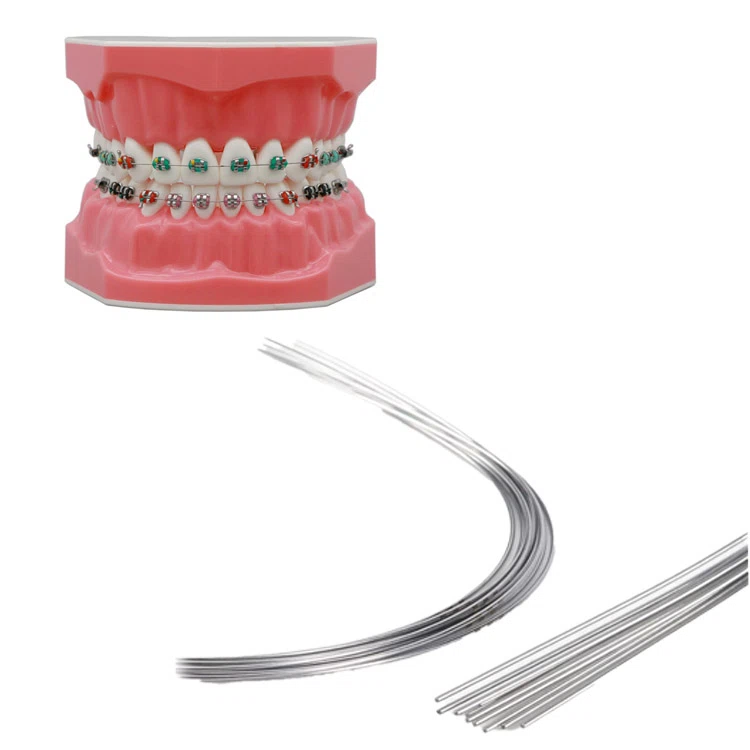
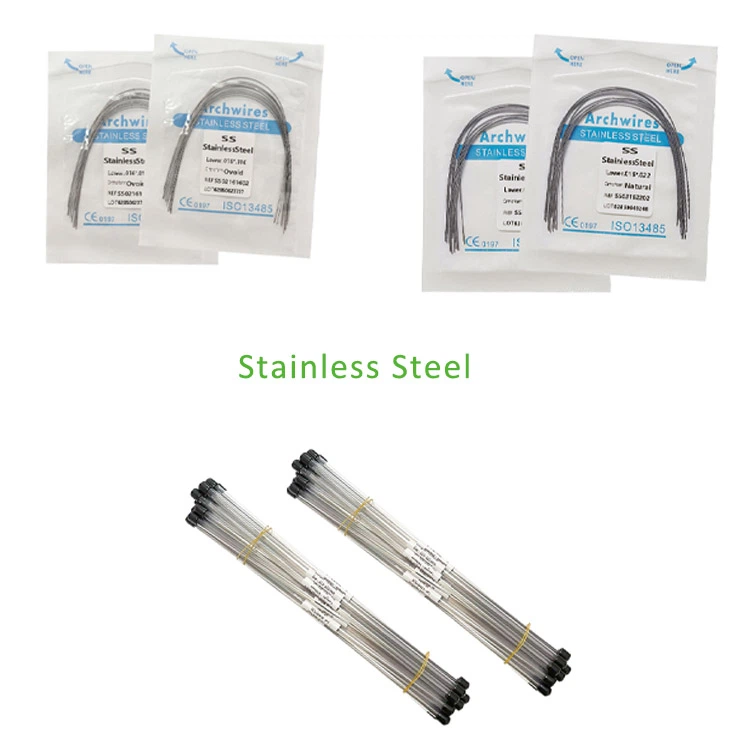
Fil d'arc orthodontique
- Niti / fil d'arc en acier inoxydable
- emballer: 10PC / Pack
- Exposent un excellent ressort de retour
- Performance cohérente
- High Poixé pour une frottement réduit
- Taille complète de la série et type de formulaire pour le choix
Le fil d'arc orthodontique applique une pression sur les dents pour les induire à se déplacer dans une position désignée. Il est généralement utilisé en conjonction avec des accolades, et en ajustant la tension et la direction du fil orthodontique, Il peut efficacement améliorer l'alignement des problèmes de dents et de morsure.
Les fils d'arc orthodontique appliquent une légère tension continue sur les points de support et d'ancrage dans les dents. Ces dents se déplaceront subtilement, mais progressivement sur une période prolongée, passer à des positions souhaitées. Le résultat d'un traitement orthodontique est l'alignement des dents, Arches dentaires symétriques, et une réduction de la minceur entre les dents, qui change le contour facial, le rendre plus harmonieux et esthétique. Les fils de la voûte orthodontique redrenent les dents et améliorent la capacité de mâcher avec une meilleure bouchée.
Catégorie de fil d'arc orthodontique
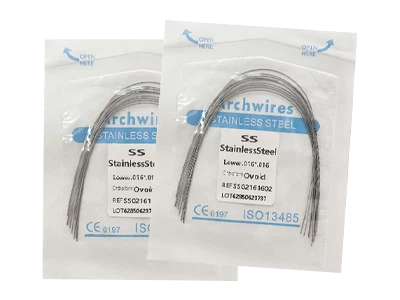
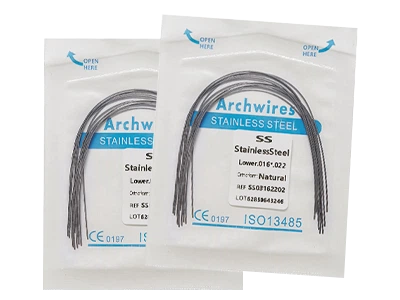
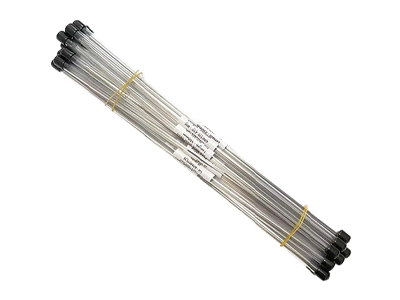
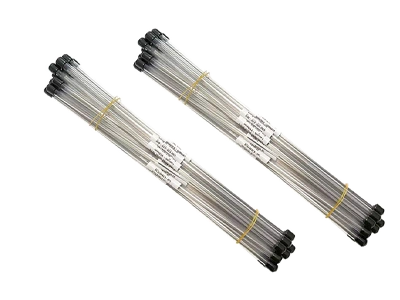
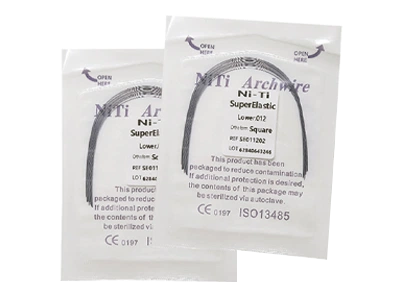
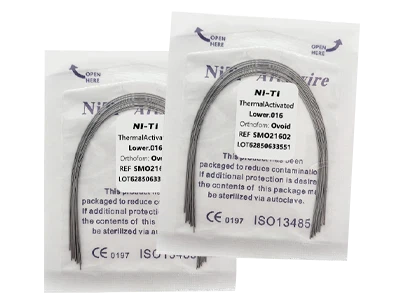
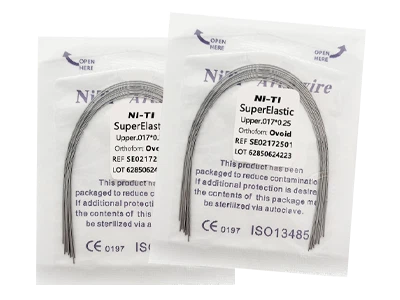
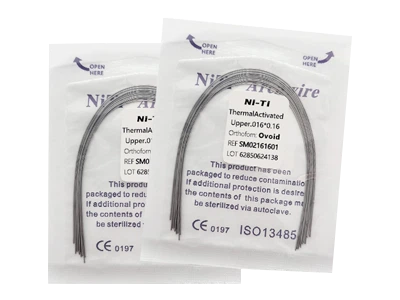
Basé sur la composition des matériaux, Nos arcs orthodontiques peuvent être classés comme des fils en acier inoxydable et des fils NITI. Tandis que le fil d'arc en acier inoxydable est bon marché et a une bonne résistance à l'abrasion et à la corrosion et est la stabilité depuis longtemps dans la cavité buccale, La dureté est élevée, Pas aussi confortable que les fils Niti, et faible sur l'élasticité. Niti Arch Wire est super élastique et a une fonction de mémoire de forme. C'est plus flexible, lui permettant de mieux s'adapter sur la surface dentaire, le rendant ainsi plus confortable mais à un prix plus élevé.
Produits connexes
La définition des arcs orthodontiques
L’arc orthodontique est un élément clé du traitement orthodontique oral. C'est un matériau en fil fin avec des propriétés mécaniques spécifiques, transmettant principalement la force orthodontique à travers le système de supports pour arcs, favorisant le mouvement lent des dents et ajustant la relation occlusale. Tout au long du processus de traitement, les fils orthodontiques jouent un double rôle en tant que “conducteur de force” et un “guide-dent”, et leurs performances affectent directement le résultat orthodontique, durée du traitement, et le confort du patient.
Les arcs orthodontiques sont généralement constitués d'alliages métalliques, tels que les fils en acier inoxydable composés de fer, chrome, et du nickel; fils en alliage nickel-titane à base de nickel et de titane; et des fils en alliage de bêta-titane comportant une base de titane alliée à des éléments comme le molybdène et le niobium.
Principe des arcs orthodontiques
Le fil d'arc orthodontique transmet avec précision la force orthodontique prédéfinie par le médecin à la dent cible grâce à sa connexion avec les supports (bases métalliques ou céramiques collées à la surface de la dent, qui sont des accessoires pour le traitement orthodontique), générer une force de compression et favoriser ainsi le mouvement lent de la dent dans l'os alvéolaire. Le but ultime est d’atteindre l’objectif thérapeutique du redressement des dents, coordonner les relations occlusales et améliorer la morphologie du visage.
Classification des matériaux et caractéristiques des fils d'arc orthodontiques
1. Fil d'acier inoxydable
- Composition: Principalement composé de métaux comme le fer, chrome, et du nickel (teneur en chrome: 17%-19%, teneur en nickel: 8%-10%), certains produits professionnels ajoutent également des éléments tels que le molybdène et le titane pour optimiser les performances.
- Caractéristiques: Forte résistance, grande rigidité, forte résistance à la corrosion, et moins sujet à la rouille dans un environnement buccal humide. Il a un module élastique modéré, qui peut fournir une force orthodontique stable et a de bonnes performances de traitement. Il peut être plié en différentes formes de fil d'arc selon les exigences du traitement.
- Étape applicable: Il est souvent utilisé aux stades intermédiaires et ultérieurs du traitement orthodontique., comme un ajustement fin après l'alignement des dents et la correction de la relation occlusale, et est particulièrement adapté aux cas ayant des exigences élevées en matière d'efficacité orthodontique.
2. Fil en alliage nickel-titane
- Composition: Un alliage à mémoire de forme composé de nickel (50%-55%) et titane (45%-50%), il peut être classé en fil de nickel-titane austénitique et en fil de nickel-titane martensitique en fonction de sa structure cristalline.
- Caractéristiques: Il a un effet mémoire de forme et une super élasticité, peut revenir à la forme prédéfinie à la température du corps, et fournit en permanence une force corrective douce et stable. Il a un faible module élastique, provoque moins d’irritation des dents, et améliore le confort du patient.
- Étape applicable: Principalement utilisé au début du traitement, comme des dents alignées et une occlusion ouverte, il est particulièrement adapté aux cas d'encombrement et de torsion dentaires importants, réduisant efficacement l’inconfort du patient.
3. Fil en alliage de titane (Fil en alliage de titane β)
- Composition: Alliages formés en ajoutant des éléments tels que le molybdène, niobium, et du zirconium au titane comme matériau de base (comme l'alliage Ti-Mo-Nb-Zr).
- Caractéristiques: Il combine la haute résistance du fil en acier inoxydable avec la bonne élasticité du fil en alliage nickel-titane., et son module élastique se situe entre les deux. Il a une bonne biocompatibilité et ne contient pas de nickel, ce qui le rend adapté aux patients allergiques au nickel. Il a une forte résistance à la corrosion et de bonnes performances de traitement, et peut être transformé en formes complexes de fil d'arc.
- Étape applicable: Il convient au stade intermédiaire du traitement orthodontique, surtout pendant la période de transition entre l'alignement des dents et l'ajustement fin. Il peut non seulement fournir une force correctrice suffisante, mais également assurer la stabilité du mouvement dentaire..
Les types de forces correctrices des fils d’arc orthodontiques
Selon la nature de la force générée par les arcs orthodontiques, ils sont principalement classés dans les types suivants:
- Force élastique: Quand les arcs orthodontiques subissent une déformation élastique, une force élastique est générée, qui est la principale source d’énergie pour le mouvement des dents. Le fil en alliage nickel-titane est le plus doux, force élastique la plus stable et la plus durable, tandis que le fil en acier inoxydable a une force élastique plus forte mais une durée relativement plus courte.
- Friction: La friction entre les fils orthodontiques et les brackets a un impact significatif sur la vitesse de déplacement des dents.. Pendant la phase d’alignement des dents, il est nécessaire de minimiser autant que possible les frottements pour améliorer l'efficacité du mouvement. Pendant la phase de réglage fin, une friction appropriée aide à maintenir la position stable des dents.
- Force de couple: La force de couple générée par la flexion de l'arc orthodontique peut contrôler l'inclinaison des lèvres et de la langue des dents., améliorer la relation occlusale et la forme du visage. Le fil en alliage de titane présente une bonne stabilité de la force de couple et constitue un matériau de contrôle de couple couramment utilisé dans la pratique clinique..
Facteurs affectant la force orthodontique des arcs orthodontiques
- Propriétés des matériaux: Le module élastique, la limite d'élasticité et la limite élastique des différents matériaux varient, qui déterminent directement l'ampleur et la durée de la force corrective. Par exemple, le fil en alliage nickel-titane a un faible module élastique, résultant en une force correctrice relativement faible mais une durée plus longue. Le fil en acier inoxydable a un module élastique élevé, fournissant une force correctrice relativement importante mais une courte durée.
- Le diamètre des fils orthodontiques: Le diamètre des fils est un facteur clé affectant la force orthodontique. Plus le diamètre est grand, plus la résistance est élevée et plus la force correctrice est grande. Plus le diamètre est petit, meilleure est l'élasticité et plus la force correctrice est faible. Les spécifications de diamètre couramment utilisées incluent 0.012 pouces, 0.014 pouces, 0.016 pouces, 0.018 pouces, 0.020 pouces, etc..
- La forme de l'arc: La forme de l'arc (comme circulaire, carré, ou rectangulaire) affecte la zone de contact avec le support et la force de friction, influençant ainsi la transmission de la force orthodontique. Le fil circulaire a une petite zone de contact et un faible frottement, ce qui le rend adapté à l'étape d'alignement des dents. Les fils carrés et rectangulaires ont une grande surface de contact, qui peuvent transmettre plus efficacement la force de couple et conviennent à l'étape de réglage fin.
Précautions concernant les arcs orthodontiques
- Maintenir l’hygiène bucco-dentaire: Une fois l'arc orthodontique connecté aux supports, les débris alimentaires ont tendance à s’accumuler. Si non nettoyé à temps, cela peut entraîner une accumulation de plaque dentaire, ce qui peut à son tour causer des problèmes tels que la carie dentaire et la gingivite.
- Évitez de mâcher des objets durs: La solidité et la résistance à l’usure des fils orthodontiques sont limitées. Mâcher des objets durs (comme les noix, os, bonbons durs, glaçons, etc.) peut provoquer la rupture des fils, se déformer ou les supports tomber, affectant la progression du traitement.
- Visites de suivi régulières: Les patients doivent bénéficier de visites de suivi régulières, selon les exigences du médecin. (Habituellement tous les 4 à 8 semaines), pour que le médecin puisse ajuster le diamètre, forme ou tension de l'arc orthodontique en fonction du mouvement des dents.
- Faites attention aux symptômes d’inconfort buccal: Après avoir porté des arcs orthodontiques pour la première fois ou effectué des ajustements, les patients peuvent ressentir une gêne telle qu'un mal de dents ou une usure de la muqueuse buccale, qui disparaît généralement progressivement au sein 1 à 2 semaines. Si l'inconfort persiste ou s'aggrave, des soins médicaux doivent être recherchés rapidement pour un examen.
FAQ
Il n’existe pas de norme fixe concernant la fréquence de remplacement des arcs orthodontiques.. Cela dépend principalement du cycle de traitement, la vitesse de déplacement des dents et les objectifs de l'étape de traitement. Généralement, pendant tout le traitement orthodontique (1.5 à 3 années), les fils orthodontiques sont remplacés 4 à 8 fois.
Conservez la pièce cassée et contactez votre dentiste. Il réajustera ou remplacera l'arc orthodontique. Ne le manipulez pas vous-même pour éviter les risques d'ingestion accidentelle.
Nettoyer délicatement la zone autour du fil d'arc et des brackets avec une brosse interdentaire, et utilisez un hydropulseur pour éliminer les débris alimentaires.
Oui. Une fois le traitement orthodontique terminé, le dentiste enlèvera tous les arcs orthodontiques, brackets et autres composants de la bouche lors de la dernière visite de suivi. Après le retrait, il nettoiera et polira la surface des dents. Il est recommandé de porter des appareils de contention pour maintenir la position stable des dents et éviter qu'elles ne rebondissent..
Les principes fondamentaux de sélection (biocompatibilité et adéquation des objectifs de traitement) sont cohérents, mais en raison des différentes conditions dentaires et parodontales des enfants et des adultes, il y a des différences détaillées.

